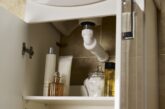Paul Tingey, Director of Customer Support Services at AKW, looks at how to cut the risk of serious scalding injuries with thermostatically controlled technology.
Scalds are just as severe as the burns caused by flames, with similar scarring and life changing consequences, but they can be prevented in the bathroom with the right solutions.
The notion that injuries from hot water are not as serious as those sustained by flames is a common misconception. Medical professionals count bath, shower and tap water scalds among the worst injuries anyone can suffer, and the resulting pain is every bit as severe as that experienced by victims of fire or explosions.
![]()
In fact, scalds can take longer to heal than dry heat wounds and the scarring left behind is often far worse, with a scald over more than 20 per cent of the body having the same impact as being hit by a bus.
Scald injuries also happen extremely quickly. Exposure to water that is 50°C for 60 seconds is enough to cause a deep burn, while at 60°C it takes just two seconds and at 70°C it takes less than a second. Once the burn has occurred there is no cure, only treatment to reduce the risk of infection and permanent scarring.
The scale of the problem can be seen in UK emergency departments, which treat almost 2,000 people with scald injuries from the tap water in their bath, sink or shower every year.
Of this number, 300 are so badly burnt that they have to be admitted to specialist burns units and many are left with life changing wounds. While scald accidents do not cause the highest number of NHS admissions, they are among the most expensive to treat – the average cost of admitted care for a bathing emersion scald per person is more than £5,100, according to the Children’s Burns Trust.
The impact on some of the most vulnerable members of society is exceptionally huge. Two thirds of all those who suffer hot water injuries are children as their skin is thinner, meaning it burns quicker, and they are less likely to be able to rapidly remove themselves from the scalding liquid source. Equally, the elderly are especially susceptible for the same reason and older people are shown to be at particular risk of dying from tap water scald injuries.
As a result, it is critical that logical action is taken to prevent scald injuries from occurring in the first place. This is straightforward when installing or upgrading bathrooms in both domestic and commercial premises with the use of specially developed devices.
In buildings where it is not possible to get a high volume of hot water from a boiler, thermostatically controlled electric showers are available that limit the water temperature to 41°C. Many conventional showers are notorious for blasting the user with hot water then cold then back again during use, which besides the scald risk is especially dangerous for people with heart conditions, whereas BEAB Care thermostatic models will automatically shut off to stop this from happening.
![]() High quality BEAB Care thermostatically controlled electric showers are designed with both the user and the installer in mind as they are quick and easy to fit, as well as use. They usually feature a simple design with push-button flow and temperature controls, while top-end models, such as AKW’s iCare, can be operated with a remote control or smartphone app.
High quality BEAB Care thermostatically controlled electric showers are designed with both the user and the installer in mind as they are quick and easy to fit, as well as use. They usually feature a simple design with push-button flow and temperature controls, while top-end models, such as AKW’s iCare, can be operated with a remote control or smartphone app.
This means two things – one, the user can set the shower to start and enter the area once it has reached the optimum temperature and, two, a carer, if needed, can maintain a comfortable temperature when they are outside the room to allow the user to shower in maximum privacy without compromising safety.
Furthermore, installation is straightforward as some modern thermostatic electric showers have eight electrical and eight water entry points, as well as terminal blocks for left or right hand wiring connections. They often feature a retrofit footprint that covers most manufacturers’ models to eliminate the need for tiling work and the majority are compatible with existing cables and pipework should the existing shower need to be replaced.
Meanwhile, thermostatically controlled mixer showers are ideal when working in premises where it is possible to take water from a combi boiler. These feature a cartridge that allows the water temperature to rise only to a maximum 41°C.
Thermostatic taps work using a similar principle as they include integrated mixer valves to prevent scalding, while thermostatic mixing valves that blend the hot and cold water to a safe temperature can also be installed on standard bathroom water outlets.
When specifying any of these solutions, it is critical that they meet the relevant standards, including Building Regulations Part G, BS EN 1111, TMV2 for the domestic market and TMV3 for use in the high risk healthcare sector, to guarantee maximum safety.
Ultimately, speaking to the end user and finding the right equipment for their needs will result in the best outcome. It takes just seconds for a scald injury to occur but the suffering can last a lifetime so prevention is vital and it is always possible.
For further information on AKW click here.








